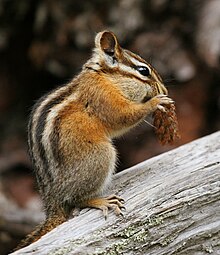Neotamias
Appearance
| Neotamias | |
|---|---|

| |
| Least chipmunk (Neotamias minimus) | |
| Scientific classification | |
| Domain: | Eukaryota |
| Kingdom: | Animalia |
| Phylum: | Chordata |
| Class: | Mammalia |
| Order: | Rodentia |
| Family: | Sciuridae |
| Tribe: | Marmotini |
| Genus: | Neotamias A. H. Howell, 1929 |
| Type species | |
| Sciurus minimus Bachman, 1839
| |
| Diversity | |
| 23 species | |
Neotamias is a genus of chipmunks within the tribe Marmotini of the squirrel family. It contains 23 species, which mostly occur in western North America. Along with Eutamias, this genus is often considered a subgenus of Tamias.[1][2][3][4][5]
Species
[edit]- Alpine chipmunk, Neotamias alpinus
- Yellow-pine chipmunk, Neotamias amoenus
- Buller's chipmunk, Neotamias bulleri
- Gray-footed chipmunk, Neotamias canipes
- Gray-collared chipmunk, Neotamias cinereicollis
- Cliff chipmunk, Neotamias dorsalis
- Durango chipmunk, Neotamias durangae
- Merriam's chipmunk, Neotamias merriami
- Least chipmunk, Neotamias minimus
- California chipmunk, Neotamias obscurus
- Yellow-cheeked chipmunk, Neotamias ochrogenys
- Palmer's chipmunk, Neotamias palmeri
- Panamint chipmunk, Neotamias panamintinus
- Long-eared chipmunk, Neotamias quadrimaculatus
- Colorado chipmunk, Neotamias quadrivittatus
- Red-tailed chipmunk, Neotamias ruficaudus
- Hopi chipmunk, Neotamias rufus
- Allen's chipmunk, Neotamias senex
- Siskiyou chipmunk, Neotamias siskiyou
- Sonoma chipmunk, Neotamias sonomae
- Lodgepole chipmunk, Neotamias speciosus
- Townsend's chipmunk, Neotamias townsendii
- Uinta chipmunk, Neotamias umbrinus
Three subspecies have recently been recognized as distinct species by some authorities:[6]
- Crater chipmunk, Neotamias cratericus, split from N. amoenus[7]
- Coulee chipmunk, Neotamias grisescens, split from N. minimus[7]
- Sierra del Carmen chipmunk, Neotamias solivagus, split from N. durangae[8]
References
[edit]- ^ Patterson, Bruce D.; Norris, Ryan W. (2016). "Towards a uniform nomenclature for ground squirrels: the status of the Holarctic chipmunks" (PDF). Mammalia. 80 (3): 241–251. doi:10.1515/mammalia-2015-0004. S2CID 9955150. Retrieved 2019-06-08.
- ^ Wilson, D. E.; D. M. Reeder (2005). "Mammal Species of the World". Archived from the original on 2007-06-23. Retrieved 2007-06-27.
- ^ Piaggio, A. J.; Spicer, G. S. (2001). "Molecular phylogeny of the chipmunks inferred from mitochondrial cytochrome b and cytochrome oxidase II gene sequences" (PDF). Molecular Phylogenetics and Evolution. 20 (3): 335–350. CiteSeerX 10.1.1.330.9046. doi:10.1006/mpev.2001.0975. PMID 11527462.
- ^ Piaggio, Antoinette J.; Spicer, Greg S. (2000). "Molecular Phylogeny of the Chipmunk Genus Tamias Based on the Mitochondrial Cytochrome Oxidase Subunit II Gene" (PDF). Journal of Mammalian Evolution. 7 (3): 147–166. doi:10.1023/a:1009484302799. S2CID 7623018.
- ^ Musser, G. G.; Durden, L. A.; Holden, M. E.; Light, J. E. (2010). "Systematic review of endemic Sulawesi squirrels (Rodentia, Sciuridae), with descriptions of new species of associated sucking lice (Insecta, Anoplura), and phylogenetic and zoogeographic assessments of sciurid lice" (PDF). Bulletin of the American Museum of Natural History. 339 (339): 1–260. doi:10.1206/695.1. hdl:2246/6067. S2CID 82712592.
- ^ "Higher Taxonomy".
- ^ a b Herrera, Nathanael D.; Bell, Kayce C.; Callahan, Colin M.; Nordquist, Erin; Sarver, Brice A. J.; Sullivan, Jack; Demboski, John R.; Good, Jeffrey M. (2 July 2022). "Genomic resolution of cryptic species diversity in chipmunks". Evolution. 76 (9): 2004–2019. doi:10.1111/evo.14546. PMID 35778920.
- ^ Ramirez-Pulido, Jose; Gonzalez-Ruiz, Noe; Gardner, Alfred; Arroyo-Cabrales, Joaquin (18 September 2014). "List of Recent Land Mammals of Mexico, 2014". Special Publications Museum of Texas Tech University. Special publications - the Museum, Texas Tech University. 63: 52. doi:10.5962/bhl.title.142891. ISBN 9781929330270. Retrieved 8 December 2023.
- Musser, G. G.; Durden, L. A.; Holden, M. E.; and Light, J. E. (2010) "Systematic review of endemic Sulawesi squirrels (Rodentia, Sciuridae), with descriptions of new species of associated sucking lice (Insecta, Anoplura), and phylogenetic and zoogeographic assessments of sciurid lice." Bulletin of the American Museum of Natural History 339.
- Piaggio, A. J. and Spicer, G. S. 2001. "Molecular phylogeny of the chipmunks inferred from mitochondrial cytochrome b and cytochrome oxidase II gene sequences." Molecular Phylogenetics and Evolution 20: 335–350.
